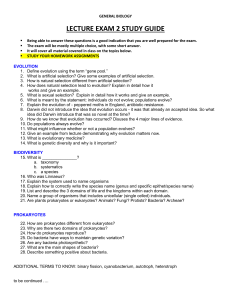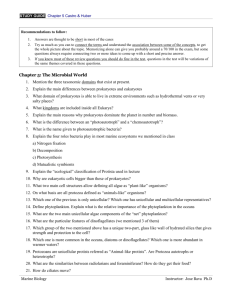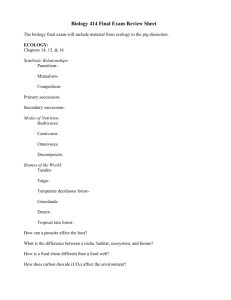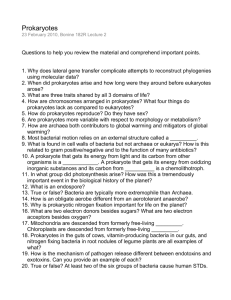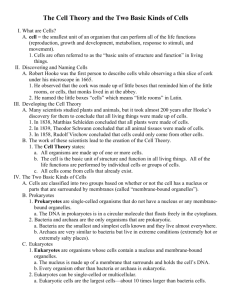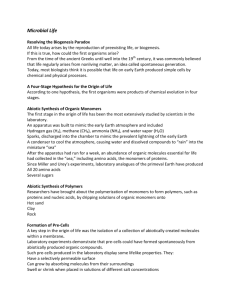Document
advertisement
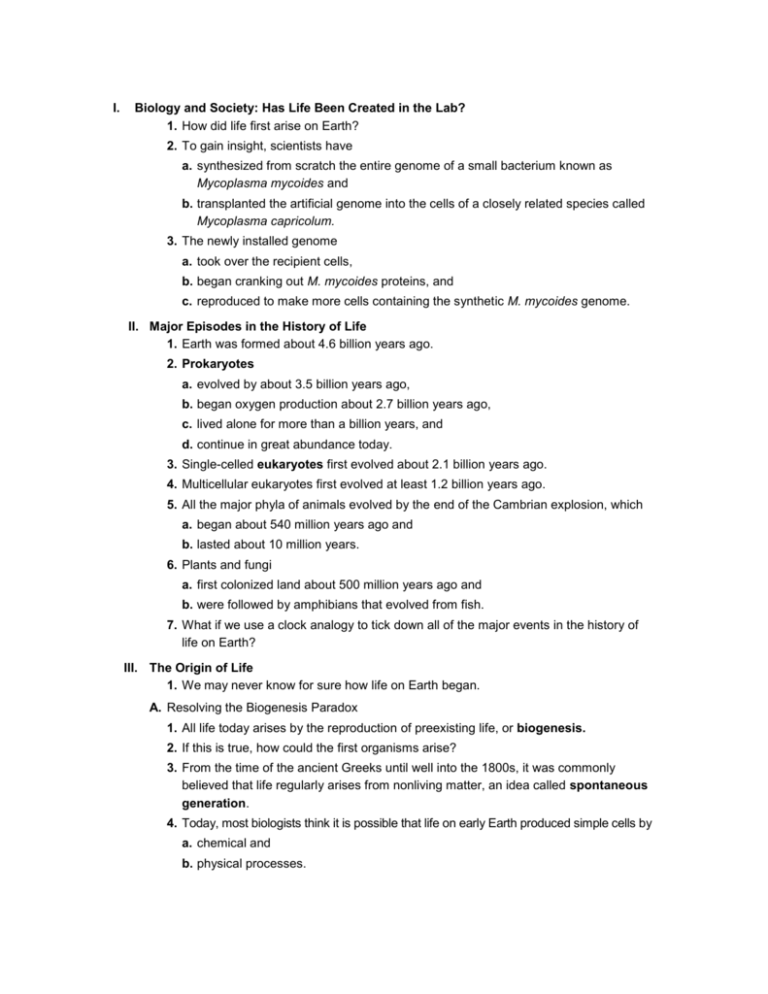
I. Biology and Society: Has Life Been Created in the Lab? 1. How did life first arise on Earth? 2. To gain insight, scientists have a. synthesized from scratch the entire genome of a small bacterium known as Mycoplasma mycoides and b. transplanted the artificial genome into the cells of a closely related species called Mycoplasma capricolum. 3. The newly installed genome a. took over the recipient cells, b. began cranking out M. mycoides proteins, and c. reproduced to make more cells containing the synthetic M. mycoides genome. II. Major Episodes in the History of Life 1. Earth was formed about 4.6 billion years ago. 2. Prokaryotes a. evolved by about 3.5 billion years ago, b. began oxygen production about 2.7 billion years ago, c. lived alone for more than a billion years, and d. continue in great abundance today. 3. Single-celled eukaryotes first evolved about 2.1 billion years ago. 4. Multicellular eukaryotes first evolved at least 1.2 billion years ago. 5. All the major phyla of animals evolved by the end of the Cambrian explosion, which a. began about 540 million years ago and b. lasted about 10 million years. 6. Plants and fungi a. first colonized land about 500 million years ago and b. were followed by amphibians that evolved from fish. 7. What if we use a clock analogy to tick down all of the major events in the history of life on Earth? III. The Origin of Life 1. We may never know for sure how life on Earth began. A. Resolving the Biogenesis Paradox 1. All life today arises by the reproduction of preexisting life, or biogenesis. 2. If this is true, how could the first organisms arise? 3. From the time of the ancient Greeks until well into the 1800s, it was commonly believed that life regularly arises from nonliving matter, an idea called spontaneous generation. 4. Today, most biologists think it is possible that life on early Earth produced simple cells by a. chemical and b. physical processes. B. A Four-Stage Hypothesis for the Origin of Life 1. According to one hypothesis, the first organisms were products of chemical evolution in four stages. 2. Stage 1: Abiotic Synthesis of Organic Monomers 3. The first stage in the origin of life was the first to be extensively studied in the laboratory. C. The Process of Science: Can Biological Monomers Form Spontaneously? 1. Observation: Modern biological macromolecules are all composed of elements that were present in abundance on early Earth. 2. Question: Could biological molecules arise spontaneously under conditions like those on early Earth? 3. Hypothesis: A closed system designed to simulate early Earth conditions could produce biologically important organic molecules from inorganic ingredients. 4. Prediction: Organic molecules would form and accumulate. 5. Experiment: An apparatus was built to mimic the early Earth atmosphere and included a. hydrogen gas (H2), methane (CH4), ammonia (NH3), and water vapor (H2O), b. sparks that were discharged into the chamber to mimic the prevalent lightning of the early Earth, and c. a condenser that cooled the atmosphere, causing water and dissolved compounds to “rain” into the miniature “sea.” 6. Results: After the apparatus had run for a week, an abundance of organic molecules essential for life had collected in the “sea,” including amino acids, the monomers of proteins. 7. These laboratory experiments a. have been repeated and extended by other scientists and b. support the idea that organic molecules could have arisen abiotically on early Earth. 8. Stage 2: Abiotic Synthesis of Polymers 9. Researchers have brought about the polymerization of monomers to form polymers, such as proteins and nucleic acids, by dripping solutions of organic monomers onto a. hot sand, b. clay, or c. rock. 10. Stage 3: Formation of Pre-Cells 11. A key step in the origin of life was the isolation of a collection of abiotically created molecules within a membrane. 12. Laboratory experiments demonstrate that pre-cells could have formed spontaneously from abiotically produced organic compounds. 13. Such pre-cells produced in the laboratory display some lifelike properties. They a. have a selectively permeable surface, b. can grow by absorbing molecules from their surroundings, and c. swell or shrink when placed in solutions of different salt concentrations. 14. Stage 4: Origin of Self-Replicating Molecules 15. Life is defined partly by the process of inheritance, which is based on self-replicating molecules. 16. One hypothesis is that the first genes were short strands of RNA that replicated themselves a. without the assistance of proteins, b. perhaps using RNAs that can act as enzymes, called ribozymes. 17. From Chemical Evolution to Darwinian Evolution 18. Over millions of years a. natural selection favored the most efficient pre-cells and b. the first prokaryotic cells evolved. IV. Prokaryotes 1. Prokaryotes lived and evolved all alone on Earth for about 2 billion years. A. They’re Everywhere! 1. Prokaryotes a. are found wherever there is life, b. have a collective biomass that is at least ten times that of all eukaryotes, c. thrive in habitats too cold, too hot, too salty, too acidic, or too alkaline for any eukaryote, d. cause about half of all human diseases, and e. more commonly can be benign or beneficial. 2. Compared to eukaryotes, prokaryotes are a. much more abundant and b. typically much smaller. 3. Prokaryotes living in soil and at the bottom of lakes, rivers, and oceans help to decompose dead organisms and other organic waste material, returning vital chemical elements to the environment. B. The Structure and Function of Prokaryotes 1. Prokaryotic cells a. lack a membrane-enclosed nucleus, b. lack other membrane-enclosed organelles, c. typically have cell walls exterior to their plasma membranes, but d. display an enormous range of diversity. 2. The three most common shapes of prokaryotes are a. spherical (cocci), b. rod-shaped (bacilli), and c. spiral or curved. 3. All prokaryotes are unicellular. 4. Some prokaryotes a. exist as groups of two or more cells, b. exhibit a simple division of labor among specialized cell types, or c. are very large, dwarfing most eukaryotic cells. 5. About half of all prokaryotes are mobile, and many of these travel using one or more flagella. 6. In many natural environments, prokaryotes attach to surfaces in a highly organized colony called a biofilm, which a. may consist of one or several species of prokaryotes, b. may include protists and fungi, c. show a division of labor and defense against invaders, and d. form on almost any type of surface, including i. rocks, ii. metal, iii. plastic, and iv. organic material including teeth. 7. Most prokaryotes can reproduce a. by dividing in half by binary fission and b. at very high rates if conditions are favorable. 8. Some prokaryotes form endospores, thick-coated, protective cells that are produced within the cells when they are exposed to unfavorable conditions. 9. Prokaryotic Nutrition 10. Prokaryotes exhibit different modes of nutrition to describe how organisms obtain energy and carbon. a. Energy i. Phototrophs obtain energy from light. ii. Chemotrophs obtain energy from environmental chemicals. b. Carbon i. Autotrophs obtain carbon from carbon dioxide (CO2). ii. Heterotrophs obtain carbon from at least one organic nutrient—the sugar glucose, for instance. 11. We can group all organisms according to the four major modes of nutrition if we combine the a. energy source (phototroph versus chemotroph) and b. carbon source (autotroph versus heterotroph). 12. Dominant among multicellular organisms are a. photoautotrophs and b. chemoheterotrophs. 13. The other two modes are used only by certain prokaryotes. C. The Two Main Branches of Prokaryotic Evolution: Bacteria and Archaea 1. By comparing diverse prokaryotes at the molecular level, biologists have identified two major branches of prokaryotic evolution: a. bacteria b. archaea (more closely related to eukaryotes). 2. Thus, life is organized into three domains: a. Bacteria, b. Archaea, and c. Eukarya. 3. Some archaea are “extremophiles.” a. Halophiles thrive in salty environments. b. Thermophiles inhabit very hot water. c. Methanogens i. inhabit the bottoms of lakes and swamps and ii. aid digestion in cattle and deer. D. Bacteria and Disease 1. Bacteria interact with people in many ways. 2. Bacteria That Cause Disease 3. Bacteria and other organisms that cause disease are called pathogens. 4. Most pathogenic bacteria produce poisons. a. Exotoxins are proteins bacterial cells secrete into their environment. b. Endotoxins are i. not cell secretions but instead ii. chemical components of the outer membrane of certain bacteria. 5. The best defenses against bacterial disease are a. sanitation, b. antibiotics, and c. education. 6. Lyme disease is a. caused by bacteria carried by ticks and b. treated with antibiotics, if detected early. 7. Biological Weapons 8. In October 2001, a. endospores of the bacterium that causes anthrax were mailed to members of the news media and the U.S. Senate and b. five people died from this attack. 9. Another bacterium considered to have dangerous potential as a weapon is Clostridium botulinum, producer of exotoxin botulinum, which a. blocks transmission of nerve signals that cause muscle contraction and b. is the deadliest poison on Earth. E. The Ecological Impact of Prokaryotes 1. Pathogenic bacteria are in the minority among prokaryotes. 2. Far more common are species that are essential to our well-being, either directly or indirectly. 3. Prokaryotes and Chemical Recycling 4. Prokaryotes play essential roles in a. chemical cycles in the environment and b. the breakdown of organic wastes and dead organisms. 5. Prokaryotes and Bioremediation 6. Bioremediation is the use of organisms to remove pollutants from a. water, b. air, and c. soil. 7. A familiar example is the use of prokaryotic decomposers in sewage treatment. 8. Certain bacteria a. can decompose petroleum and b. are useful in cleaning up oil spills. V. Protists 1. Protists are a. eukaryotes that are not fungi, animals, or plants, b. mostly unicellular, and c. ancestral to all other eukaryotes. A. The Origin of Eukaryotic Cells 1. Eukaryotic cells evolved by a. the infolding of the plasma membrane of a prokaryotic cell to form the endomembrane system and b. endosymbiosis, one species living inside another host species, in which freeliving bacteria came to reside inside a host cell, producing mitochondria and chloroplasts. 2. Symbiosis is a more general association between organisms of two or more species. B. The Diversity of Protists 1. The group called protists a. consists of multiple clades but b. remains a convenient term to refer to eukaryotes that are not plants, animals, or fungi. 2. Protists have a variety of ways in which they obtain their nutrition. a. Algae are autotrophs, producing their food by photosynthesis. b. Other protists are heterotrophs. i. Some protists eat bacteria or other protists. ii. Other protists are fungus-like and obtain organic molecules by absorption. iii. Parasites derive their nutrition from a living host, which is harmed by the interaction. Parasitic trypanosomes infect blood and cause sleeping sickness. 3. Protist habitats are diverse and include a. oceans, lakes, and ponds, b. damp soil and leaf litter, and c. mutually beneficial relationships such as the unicellular algae that inhabit the bodies of i. reef-building coral animals or ii. the intestinal tracts of termites. 4. Protozoans 5. Protists that live primarily by ingesting food are called protozoans. 6. Protozoans with flagella are called flagellates and a. are typically free-living, but b. some are nasty parasites. 7. Amoebas are characterized by a. great flexibility in their body shape and b. the absence of permanent organelles for locomotion. 8. Most species move and feed by means of pseudopodia (singular, pseudopodium), temporary extensions of the cell. 9. Other protozoans with pseudopodia include the forams, which have shells. 10. Apicomplexans are a. named for a structure at their apex (tip) that is specialized for penetrating host cells and tissues, b. all parasitic, and c. able to cause serious human diseases, such as malaria caused by Plasmodium. 11. Another apicomplexan is Toxoplasma, a. occurring in the digestive tracts of millions of people in the United States but b. held in check by the immune system. 12. A woman newly infected with Toxoplasma during pregnancy can pass the parasite to her unborn child, who may suffer nervous system damage. 13. Ciliates are protozoans that a. are named for their use of hair-like structures called cilia to move and sweep food into their mouths, b. are mostly free-living (nonparasitic), such as the freshwater ciliate Paramecium, and c. include heterotrophs and mixotrophs. 14. Slime Molds 15. Slime molds resemble fungi in appearance and lifestyle, but the similarities are due to convergence, and slime molds are more closely related to amoebas than to fungi. 16. The two main groups of these protists are a. plasmodial slime molds and b. cellular slime molds. 17. Plasmodial slime molds a. are named for the feeding stage in their life cycle, an amoeboid mass called a plasmodium, b. are decomposers on forest floors, and c. can be large. 18. Cellular slime molds have an interesting and complex life cycle consisting of a. a feeding stage of solitary amoeboid cells, b. a slug-like colony that moves and functions as a single unit, and c. a stalk that develops into a multicellular reproductive structure. 19. Unicellular and Colonial Algae 20. Algae are a. photosynthetic protists whose chloroplasts support food chains in i. freshwater and ii. marine ecosystems. 21. Many unicellular algae are components of plankton, the communities of mostly microscopic organisms that drift or swim weakly in aquatic environments. 22. Unicellular algae include a. dinoflagellates, with i. two beating flagella and ii. external plates made of cellulose, b. diatoms, with glassy cell walls containing silica, and c. green algae, which are i. unicellular in most freshwater lakes and ponds, ii. sometimes flagellated, such as Chlamydomonas, and iii. sometimes colonial, forming a hollow ball of flagellated cells as seen in Volvox. 23. Seaweeds 24. Seaweeds a. are large, multicellular marine algae, b. grow on or near rocky shores, c. are only similar to plants because of convergent evolution, d. are most closely related to unicellular algae, and e. are often edible. 25. Seaweeds are classified into three different groups, based partly on the types of pigments present in their chloroplasts: a. green algae, b. red algae, and c. brown algae (including kelp). C. Evolution Connection: The Origin of Multicellular Life 1. Multicellular organisms have a. specialized cells that are dependent on each other and perform different functions, such as i. feeding, ii. waste disposal, iii. gas exchange, and iv. protection. 2. Colonial protists likely formed the evolutionary links between a. unicellular and 3. b multicellular organisms. The colonial green alga Volvox demonstrates one level of specialization and cooperation
